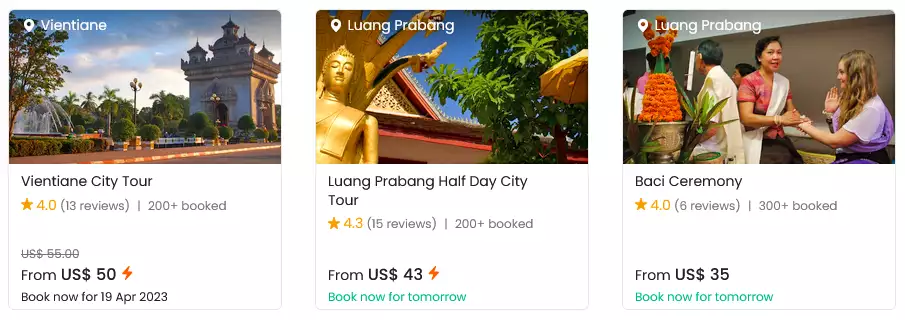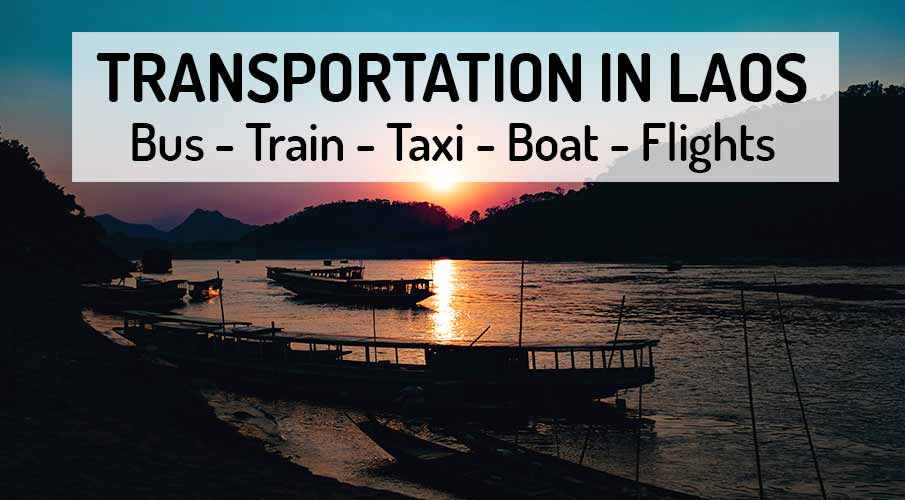
🚍 Transport by bus
🚆 Transport by train
✈️ Transport by plane
🚢 Transport by boat
🚕 Transport by taxi
🛺 Transport by tuk-tuk
🛵 Travel on a motorbike
🛤 TOP Travel Routes
🚶 Book a Tour in Laos
🎫 Book Tickets Online
Laos offers several transportation options throughout the country.
-
- Laos stands as a coveted destination in Southeast Asia, sharing its border with Vietnam. As a favored spot among travelers, navigating transportation within Laos requires thoughtful planning. While the country continues its gradual modernization, an array of transportation options is now available, including tourist buses, minivans, trains, private cars/taxis, flights connecting major cities, and scenic boat tours. In bustling cities like Vientiane and Luang Prabang, tuk-tuks offer convenient travel options, while those with international driver’s licenses can explore on motorbikes. However, motorbike travel is recommended only for experienced riders. Bicycle rentals are also available at tourist hubs. Given Laos’s predominantly mountainous terrain, land transport, such as buses or minivans, may entail longer travel times due to road conditions. For swifter journeys, air travel remains the most efficient option in Laos.
-
- A significant number of travelers embark on their journey to Laos from Vietnam. Among the most economical means of transportation in Laos are the various bus services or the Laos-China railway. As Laos undergoes ongoing modernization and development, road infrastructure is continuously improved, with plans for expanding the railway network in the future. Additionally, travelers have the option to arrange private transfers between different sites in Laos, such as Vang Vieng, Luang Prabang, and Vientiane. Various transportation companies offer modern and luxurious minivans, vans, or private cars for added comfort and convenience. Key travel routes include journeys from Vientiane to Luang Prabang and from Vang Vieng to Vientiane. Additionally, from Vientiane, crossing the border to Thailand is easily achievable, as Vientiane is situated just 20 km from Thailand.
| Transport Option in Laos | Key Routes | Additional Information |
|---|---|---|
| Tourist Buses | Vientiane – Luang Prabang | Comfortable buses + train available for popular routes. |
| Minivans | Vang Vieng – Vientiane | Quick transportation option for shorter distances. |
| Trains | Lao-China Railway | Railway connecting Vientiane – Luang Prabang – Boten. |
| Private Cars / Taxis | Customized routes | Flexibility and comfort for personalized travel. |
| Flights | Luang Prabang – Pakse | Fastest way to travel between major cities. |
| Boat Tours | Mekong River | Scenic journeys along the Mekong River. |
What types of transport you can use in Laos?
1. Transport by Bus / Minivan in Laos
-
- transfer by bus or minivan is the most popular and cheap way of transport in Laos
- there are various modern tourist seat or sleeper buses between big cities and popular sites
- you can also use modern and comfortable van / minivan, these modern minivans are faster
- bus tickets in Laos are cheap and there are lots of bus travel routes, but these buses are not so fast
- there are lots of various private bus companies in Laos
- the most popular routes are from Vientiane to Vang Vieng or Vientiane to Pakse
- you can also travel by tourist bus / minivan via the border crossing to Vietnam, Cambodia, Thailand
- from Vientiane to Bangkok in Thailand and from Vientiane to Hanoi in Vietnam
- for the most popular travel routes it is better to book and buy bus tickets in Laos online in advance
- you can book bus tickets in Laos easily online, book bus tickets with Baolau ➜ or 12go.asia ➜
Transport by Tourist Bus / Van in Laos – Pros + Cons:
| Pros | Cons |
|---|---|
| Cost: One of the primary advantages of bus transportation in Laos is its affordability. For budget-conscious travelers, buses offer a cost-effective means of exploring the country, allowing for an extended and economical journey. | Speed: A notable drawback is the potential for slower travel. Laos‘ winding roads and occasional delays can result in extended travel times, making buses less time-efficient compared to other transportation options. |
| Network: Buses in Laos operate on an extensive network that connects major cities and towns. This wide-reaching connectivity makes bus transportation a convenient choice, facilitating travel across various regions of the country. | Accessibility: While the bus network is extensive, it may not reach more remote or less-traveled areas. This limitation could restrict access to certain picturesque or less-commercialized locations that are better reached by private vehicles. |
| Scenery: One of the delightful aspects of bus travel in Laos is the opportunity to enjoy the country’s scenic beauty. The journey through lush landscapes, picturesque villages, and winding mountain roads provides a unique and immersive experience for travelers. | Travel Time: While the scenery is a highlight, the long travel times on winding roads may not be suitable for everyone. Travelers prone to motion sickness or discomfort during extended periods of bus travel might find this a significant drawback. |

2. Transport by Train in Laos
-
- transfer by train is another popular and fast way of transport in Laos
- there is a railway from Vientiane to Boten (via Vang Vieng, Luang Prabang) to the border with China
- railway schedule and network in Laos is very limited, but it is a comfortable and fast option of transfer
- you can use Laos-China Railway train, check the current Laos Railway Map
- the first historical modern railway route was opened in December 2021
- there is a modern high-speed train and ordinary train in Laos
- this railway is a part of the Vientiane – Kunming railway transport
- rail transport in Laos is a bit more expensive than bus transport
- you can book train tickets in Laos also online, book tickets with Baolau ➜ or 12go.asia ➜
Transport by Train in Laos – Pros + Cons:
| Pros | Cons |
|---|---|
| Comfort: Train travel in Laos often provides a more comfortable experience with spacious seating, dining options, and the ability to move around during the journey. | Limited Network: The railway network in Laos is not as extensive as in some other countries, limiting the number of destinations accessible by train. |
| Scenery: Train journeys in Laos offer picturesque views of the countryside, making it a scenic and enjoyable way to travel through the country. | Availability: Trains may have limited availability, especially on certain routes, requiring travelers to plan ahead and book tickets well in advance. |
| Environmental Impact: Train travel is generally considered more environmentally friendly compared to some other forms of transportation, contributing to sustainable tourism. | Infrequent Schedules: Train schedules in Laos may be less frequent compared to other modes of transport, requiring careful planning for travelers. |

3. Transport by Plane in Laos
-
- transfer by plane is the fastest and most comfortable option of transport in Laos
- there are flights between Vientiane – Luang Prabang – Pakse – Savannakhet – Oudomsay – Houelsay
- there are also international flight from Laos to Thailand, Vietnam, Cambodia or China
- flight schedule and airport map in Laos is very limited
- airlines in Laos: Lao Airlines, Lao Skyway
- the most frequented airports for international tourists are in Vientiane and Luang Prabang
- you can book flights in Laos or from / to Laos online, book flights with Baolau ➜ or 12go.asia ➜
Transport by Plane in Laos – Pros + Cons:
| Pros | Cons |
|---|---|
| Speed: Air travel in Laos is the fastest mode of transportation, reducing travel time significantly compared to other options. | Cost: Airfare can be relatively higher compared to other modes of transport, making it less budget-friendly for some travelers. |
| Accessibility: Airports in Laos connect major cities and provide access to remote areas, increasing accessibility to various destinations. | Environmental Impact: Air travel contributes to carbon emissions and has a higher environmental impact compared to some other transportation methods. |
| Comfort: Flights often offer a higher level of comfort, with amenities such as spacious seating, in-flight entertainment, and meal services. | Limited Routes: The number of direct flight routes within Laos may be limited, requiring layovers or alternative transportation for certain destinations. |
| Convenience: Air travel provides convenience with fixed schedules and efficient boarding processes, reducing wait times for travelers. | Local Experience: Compared to ground transportation, flying may offer a less immersive experience of local culture and scenery. |

4. Transport by Tourist Boat in Laos
-
- transfer by boat on Mekong river is another option how to explore Laos
- you can travel by boat at various cities of Laos, e.g. in Pakse, Savannakhet, Nakhon Phanom, Vientiane…
- on some sections of the Mekong River, boats function as a means of transportation across the river
- there are various private boat companies in Laos
- tickets can be purchased at the spot / piers or you can ask at the hotel or in the city center
- there are various private boat companies in Laos, e.g. Mekongboat, Vat Phou Cruises, Banana Boat Laos…
Transport by Tourist Boat in Laos – Pros + Cons:
| Pros | Cons |
|---|---|
| Scenic Views: Boat travel in Laos offers breathtaking views of rivers, landscapes, and local life, providing a unique and picturesque experience. | Speed: Boats can be slower than some other modes of transportation, especially for long distances, affecting overall travel time. |
| Cultural Experience: Traveling by boat allows for a more immersive cultural experience, connecting travelers with riverside communities and traditional practices. | Limited Routes: The availability of boat routes may be limited, restricting access to certain destinations not situated along navigable waterways. |
| Relaxation: Boat travel can be a relaxing and enjoyable way to explore Laos, offering a serene atmosphere and a break from the hustle and bustle of land travel. | Weather Dependency: Boat travel may be affected by weather conditions, leading to cancellations or changes in schedule during adverse weather. |
| Access to Remote Areas: Boats provide access to remote areas and riverine destinations that may not be easily reachable by road or air. | Comfort: Depending on the type of boat, comfort levels may vary, and long journeys may pose challenges for some passengers. |
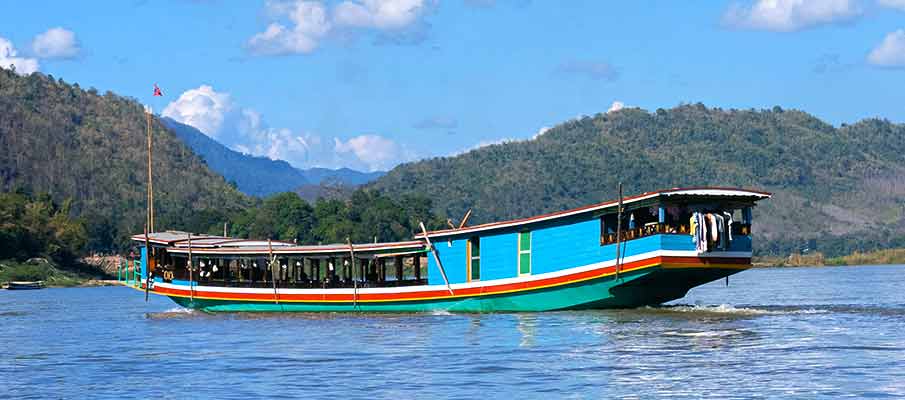
5. Transport by Private Taxi / Car in Laos
-
- transfer by private taxi / car is a popular option of transport by tourists in the big cities
- it is also possible to travel by private taxi/car between Vientiane – Vang Vieng
- there are various private local taxi companies for tourists in Laos
- transport by private taxi is the most expensive option of transfer in Laos
- it is also possible to use Loca taxi booking application
- you can use Loca service in Vientiane, Luang Prabang, Pakse, Savannakhet or Vang Vieng
Transport by Private Taxi / Car in Laos – Pros + Cons:
| Pros | Cons |
|---|---|
| Convenience: Private taxis/cars offer door-to-door service, providing the convenience of personalized transportation without the need for multiple stops. | Cost: Private transportation can be more expensive than other modes, especially for solo travelers or short distances. |
| Flexibility: Travelers have the flexibility to set their own schedule and make impromptu stops along the way, offering a customized and adaptable travel experience. | Environmental Impact: Individual car travel contributes to environmental pollution and traffic congestion, impacting sustainability. |
| Comfort: Private cars often provide a higher level of comfort, with air conditioning and personalized space for passengers. | Accessibility: In some remote areas, especially those lacking well-maintained roads, private cars may face accessibility challenges. |
| Time Efficiency: Private transportation can be more time-efficient, reducing travel time compared to certain public transportation options. | Local Interaction: Unlike public transportation, private cars may offer less interaction with local people and culture, limiting the immersive experience. |
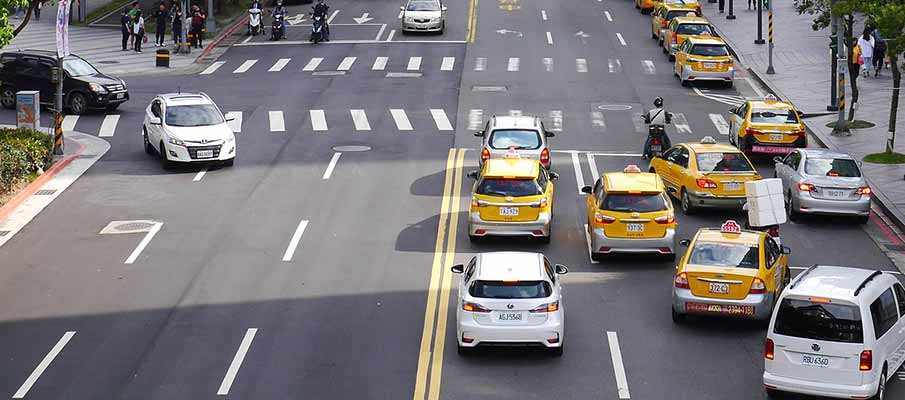
6. Transport by Tuk-Tuk in Laos
-
- transfer by tuk-tuk / rickshaw is another option of transport mainly in the big cities or at the tourist attractions
- tuk-tuk is also very cheap way of transfer in the city, it costs about $1-4, you can bargain about the price
- it is better to agree on the price before you leave the site
- some drivers also speak a little English, it is not a problem to talk with them
Transport by Private Tuk – Tuk in Laos – Pros + Cons:
| Pros | Cons |
|---|---|
| Affordability: Tuk-tuks are generally a cost-effective means of transportation, offering budget-friendly options for short-distance travel. | Weather Exposure: Tuk-tuks provide limited protection from the weather, exposing passengers to rain or extreme heat. |
| Maneuverability: Tuk-tuks can navigate through narrow streets and congested traffic, providing a convenient mode of transport in urban areas. | Limited Seating: Tuk-tuks have limited seating capacity, which may be insufficient for larger groups or families. |
| Local Experience: Riding in a tuk-tuk offers a more authentic and local travel experience, allowing interaction with the culture and surroundings. | Safety Concerns: Tuk-tuks may have minimal safety features, and accidents, though rare, can pose risks to passengers. |
| Flexibility: Tuk-tuks are versatile and can reach areas not easily accessible by larger vehicles, providing flexibility in travel routes. | Noise and Pollution: Tuk-tuks are often noisy and contribute to air pollution, which can be a concern for environmental impact. |
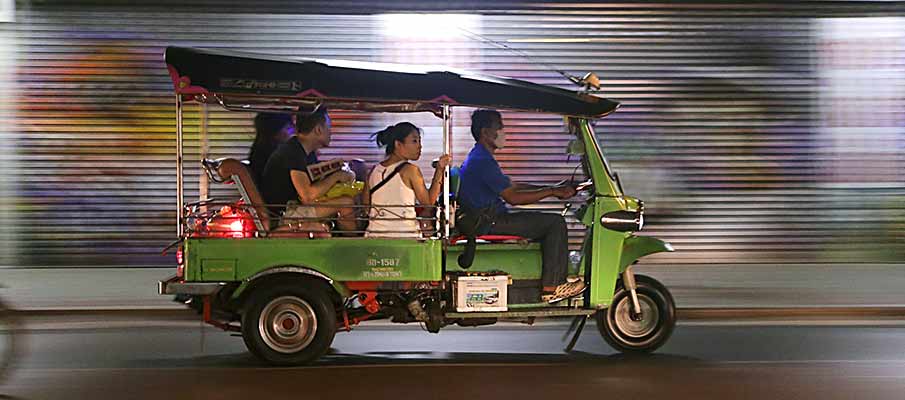
7. Travel on a Motorbike in Laos
-
-
- transfer by motorbike is another option of transport mainly by Laos people
- tourists can also rent a motorbike, but IDP is necessary if you want to drive a bike in Laos
- to rent a cheap motorycle in Laos costs about $7-12/pp
- it is better to agree on the price of rent before you leave the site
- you can rent a motorbike mainly in Vientiane, Luang Prabang, Vang Vieng, Pakse
- you can also use a private motorbike tour with Lao Adv Tours (in Luang Prabang)
- you can also read this article: Motorbike Travel Guide in Laos
-
Transport by Motorbike in Laos – Pros + Cons:
| Pros | Cons |
|---|---|
| Flexibility: Motorbikes provide flexibility in navigating through traffic and reaching destinations not easily accessible by larger vehicles. | Safety Risks: Riding a motorbike carries inherent safety risks, and accidents can result in more severe injuries compared to other modes of transport. |
| Cost: Motorbike rental and fuel costs are generally lower than other forms of transportation, making it a budget-friendly option. | Weather Exposure: Riders are exposed to the elements, including rain and sun, which may impact comfort during adverse weather conditions. |
| Maneuverability: Motorbikes can navigate through congested traffic and winding roads with ease, offering better maneuverability. | Limited Storage: Motorbikes have limited storage capacity, restricting the amount of luggage or items that can be carried. |
| Local Experience: Riding a motorbike allows for a more immersive and local travel experience, connecting with the culture and surroundings. | Physical Strain: Long rides on a motorbike can be physically tiring, especially for those not accustomed to extended periods of riding. |
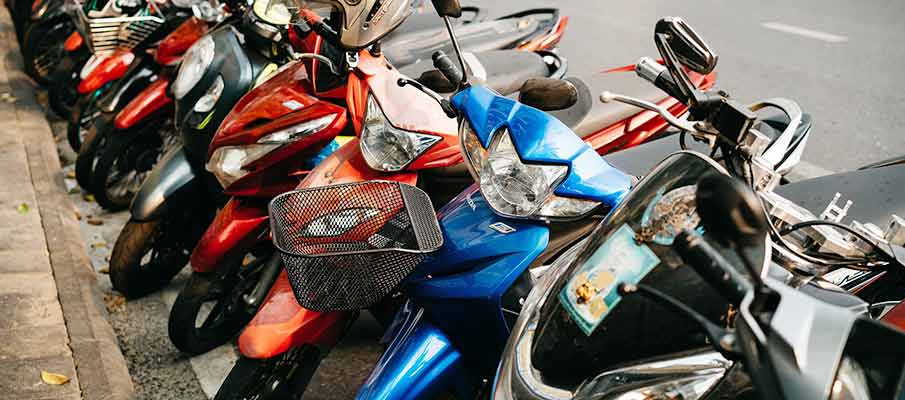
❓ FAQ + Travel Tips – Transportation in Laos:
1. How to book tickets, taxi, car + flights for transport in Laos?
-
- You can book tickets, cars and flights for transport in Laos online on Baolau ➜ or 12go.asia ➜.
- there are various tourist buses, privatevehicles, train, flights or ferries in Laos or other country of Asia.
2. Where to search and book international flights to Laos?
-
- You can search + book international + cheap flights to Laos and other deals with Trip.
3. What’s the most favorite option of transportation in Laos?
-
- The most favorite option of transportation for tourists in Laos is the bus, van / minivan or plane. Travel by tourist bus or minivan is also the most cheapest way of transfer in Laos, but it is not so fast. Another popular option are flights between Vientiane – Luang Prabang – Pakse.
4. Is there a train in Laos, and what about the railway network?
-
- Yes, there is the Lao-China Railway from Vientiane to Boten (via Vang Vieng, Luang Prabang). Boten is the border town with China, and from this place you can travel by train to Kunming. You can check current Laos Train Map.
5. What is the best way how to get to Vietnam from Laos?
-
- From Laos to Vietnam you can travel by tourist bus or you can take a flight (from Luang Prabang, Vientiane) . There are direct flights from Luang Prabang to Hanoi and from Vientiane to Hanoi or flights from Luang Prabang to Saigon and from Vientiane to Saigon.
6. What is the most cheapest way of transportation in Laos?
-
- The most cheapest way of transportation in Laos is to travel by bus, minivan or train of Lao-China Railway.
7. Is Grab available in Laos?
-
- No, Grab is not available in Laos, but you can use Loca, it is a similar service to Grab, you can use this private taxi service in Vientiane, Luang Prabang, Pakse, Savannakhet and Vang Vieng.
8. What about boats, where you can travel by boat / ferry in Laos?
-
- Laos has no sea and ocean. But you can use various private boats on Mekong river. You can travel by boat at various cities of Laos or there are several days private boat tours for tourists.
9. Is it possible to rent a bicycle in Laos?
-
- Yes, sure, in some cities it is possible to rent a bicycle and explore these towns on your own. You can also ask for this option of transfer at your hotel / homestay.
10. Is there Uber in Laos?
-
- No, Uber is not available in Laos. But you might find local or regional ride-sharing or taxi services. It’s a good idea to check with locals or use local transportation apps if they are available. Common alternatives to Uber in various countries include services like Grab, Loca or Gojek, or local taxi companies that may have their own apps.
11. What is the most frequented and major airport in Laos?
-
- The most frequented and main airport of Laos is Wattay International Airport in Vientiane – the capital of Laos. Another important airport is Luang Prabang International Airport in Luang Prabang.
12. Can I rent a motorbike in Laos?
-
- Yes, you can rent a motorbike in Laos, but it’s important to make sure you have the proper documentation and are aware of the risks involved. Laos has a high rate of traffic accidents, particularly involving motorbikes.
13. Can I travel by boat in Laos?
-
- Yes, boats are a common mode of transportation in Laos, particularly in areas along the Mekong River. There are both public and private boats available, and they can be used for transportation as well as for scenic river tours.
14. Is it safe to travel by road in Laos?
-
- While Laos has made significant improvements to its road infrastructure in recent years, road travel can still be risky due to poor road conditions, reckless driving, and the lack of road safety laws and enforcement. It’s important to exercise caution and be aware of the risks when traveling by road in Laos.
15. How to travel from Laos to Thailand and Cambodia?
-
- The best way how you can go to Thailand from Laos is to travel from Vientiane to Bangkok or to Nong Khai border town in Thailand. From Laos to Cambodia you can travel by plane, there are flights to Phnom Penh or Siem Reap or you can travel by bus/minivan from Pakse or Don Det to Siem Reap.
16. How to travel to Laos from Vietnam?
-
- You can reach Laos from Vietnam by plane or tourist sleeper bus. There is no railway between these countries, but there are some plans to build a railway in the future. The best and fastest option of transfer from Vietnam to Laos is to travel by plane, there are some direct flights.
BOOK a TOUR / ACTIVITY in Laos ➜
